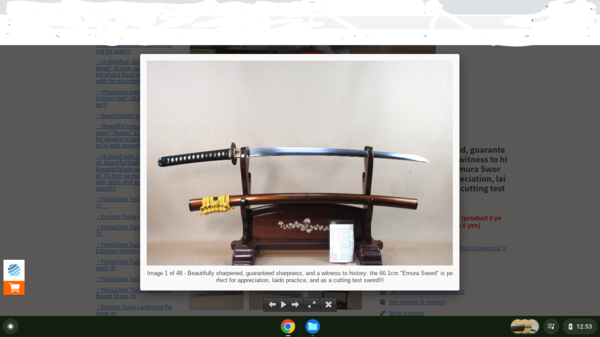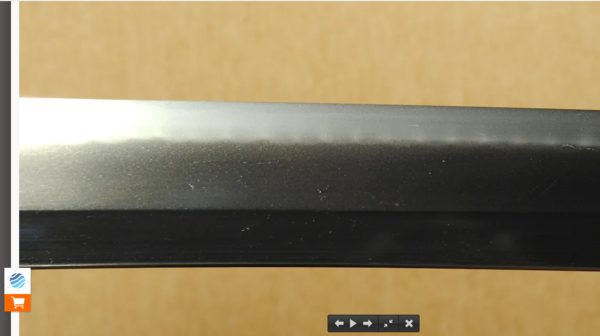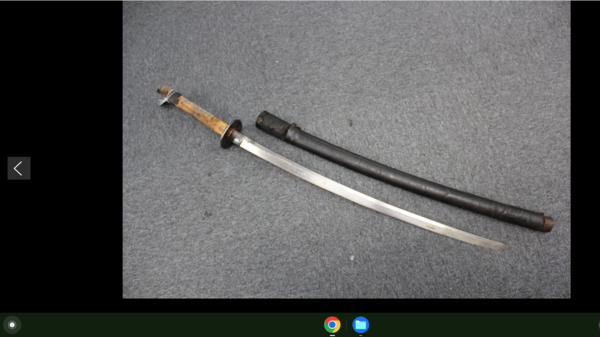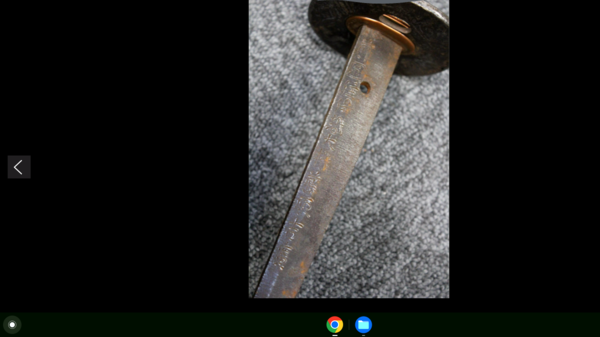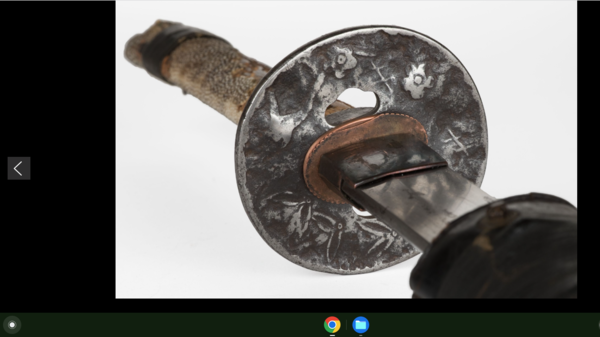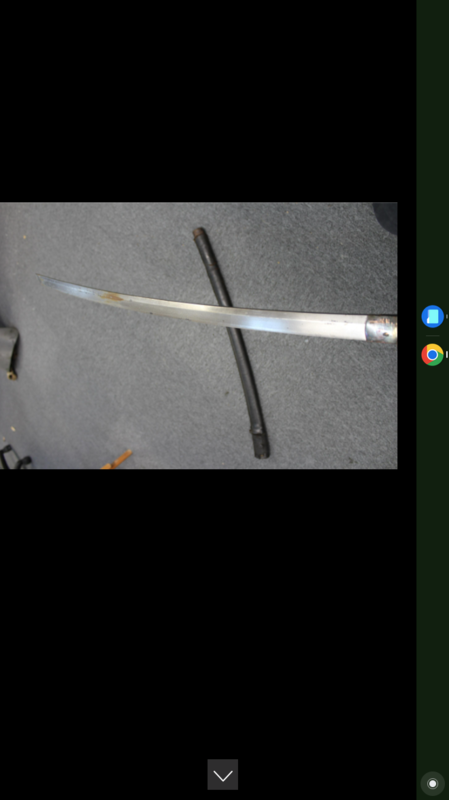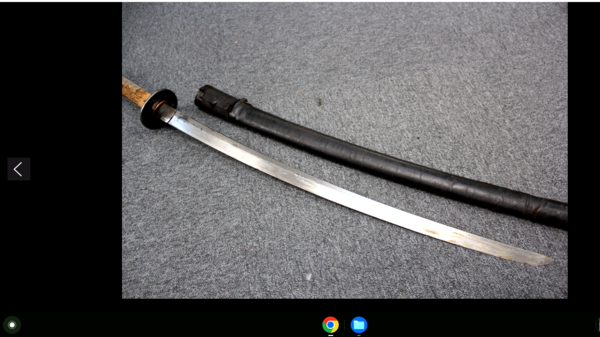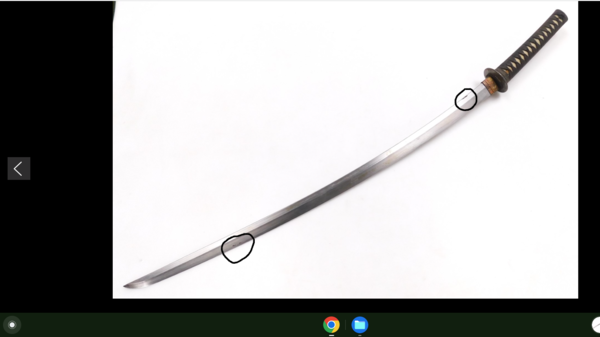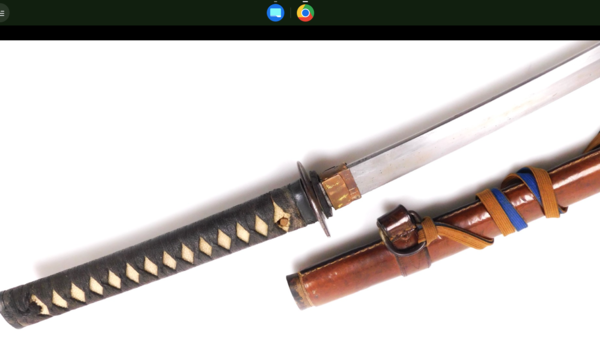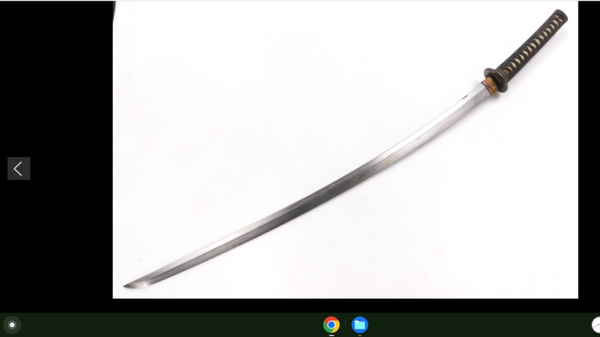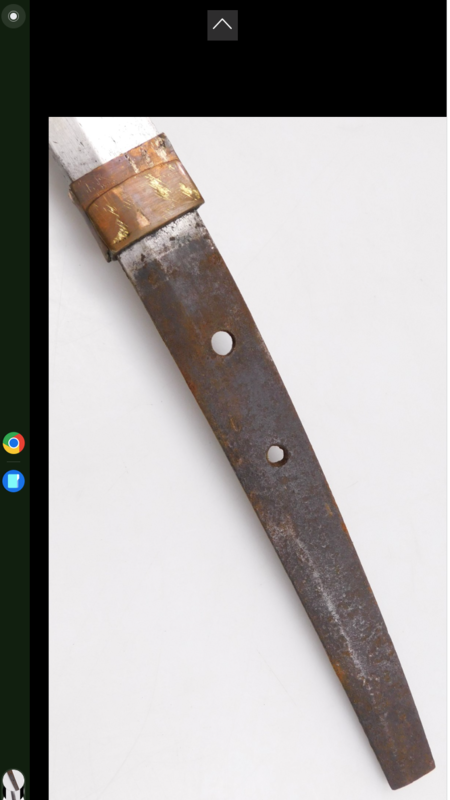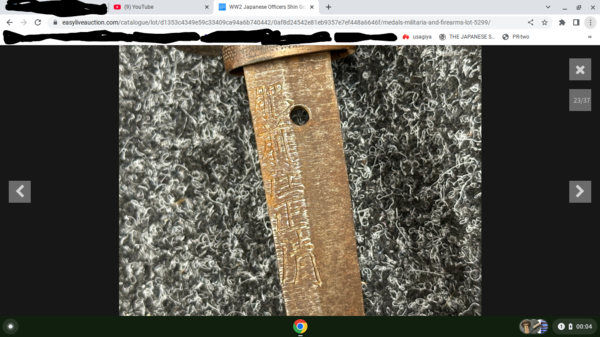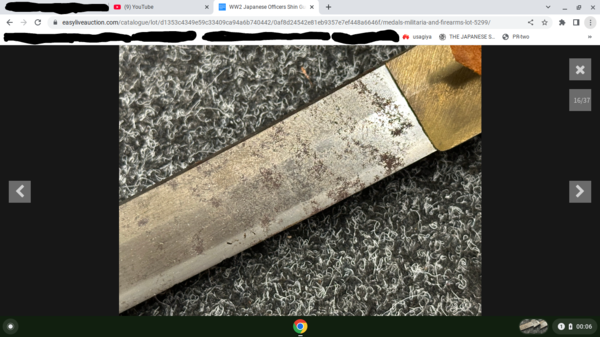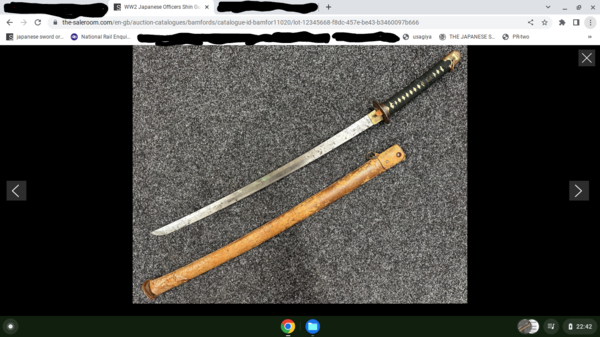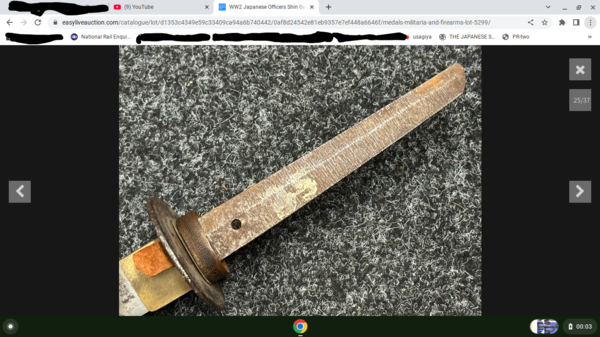
charlesf
Members-
Posts
36 -
Joined
-
Last visited
Content Type
Profiles
Forums
Events
Store
Downloads
Gallery
Everything posted by charlesf
-
Repurposed for iaido,you're probably correct about it being for a Type 3 although I have seen Type 98's with blades drilled with two holes. charles.
-
Here's a nice one from Ikedaart,doesn't say how much it sold for but interestingly is signed katana mei,also shows the Emura elongated kissaki whicj I think makes them look sharper and more elegant. charles.
-
Dear Sam, You won't spoil my mood! I thoroughly enjoy the discussion and interaction on this thread and your input is most valuable,it's always good to have a different perspective on the issue. Thanks and kind regards, charles.
-
Thanks Pav, Yes,I got quite excited at finding another Emura . . . . . . until I saw the price. The seller did have two,one mounted and the other a bare blade,this would be a couple of years ago,both blades in poor condition with lots of pitting,I did email him for his best price,he replied "Make an offer ....". I thought he might be offended by £300 so didn't respond . . . . Like the No. 10 bus,there'll be another come along shortly! regards, charles.
-
Sam, There are Emura blades 'out there',I know of two in an English antique shop in poor condition and grossly over priced (I think one of Pav's photos is one of them). I think your estimate of 'several thousand' blades is a bit strong considering that the personnel involved were not trained sword smiths having served an apprenticeship but inmates schooled by an amateur sword smith. Although the forge was state sponsored that would not guarantee an endless flow of raw material,the economy was on a war footing so there must have been restrictions on supply,priority (who got first call) and transport. I also read that Emura-san was responsible for all yaki-ire,which I presume means from applying the clay to quenching the blade,all very time consuming and would limit output,the Yasukuni smiths produced just over 8,000 swords from 1933-1945 and while it's wrong to draw a direct comparison it gives at least some idea of sword production. Emura-to were produced with power hammers apparently,which would be quicker than hand forging but still a lengthy process. I am a big Emura fan,I think they show 'character' as opposed to many RJT blades that can look a bit bland and those that I own and have owned have all been good in the hand,well built and designed for combat. Keep the Emura faith! charles.
-
Thank you! Last picture; 'Hizen Kuni No Ju Ise Daijo Fujiwara Yoshihiro'. I've no idea whether 1st or 2nd generation. charles.
-
Your sword has nice fittings but is an iaito with an alloy,not steel,blade,made for the practice of iaido. charles.
-
All in,delivered to my door it totalled £510 which I think is reasonable for a signed Hizen-to albeit not in perfect condition. As far as I can tell the signature is good and compares favourably to those shown on commercial sword sites. It was a bit of a no-brainer for me,I've always admired Hizen-to but they are usually out of my reach financially so this is an opportunity to study one first-hand while not breaking the bank. charles.
-
-
Just arrived this morning,my latest 'rescue' to be housed in my orphanage for rough swords . . . . What you see here is what I had to use to bid on (I can hear the groans already!),so you can determine whether or not you would have tried to buy it! Auction house described it as 70 cms blade,they invariably measure from tip to guard so no surprise to find it measures a touch under 27". It is genuine ubu,the brown streaks are grease,there are one or two areas of light pitting,a slight 'wriggle' in the middle of the blade and the very tip of the kissaki has gone. Tsuka has lost amost all of its same,it was a civilian hilt cut for a kashira,plain iron fuchi and signed tsuba (I'll try to take a photo). nagasa; 68.2 cms motohaba; 3 cms sakihaba; 2 cms nakago;21.2 cms Tall shakudo habaki; 3.3 cms hamon; medium suguha charles
-
George, Thanks for your kind words,you're correct about the habaki,it's been forced over the munemachi and split so that it won't seat properly.If I hold it in place the ensemble comes together as it should so I've no doubts that the tsuba is correct. The kissaki conforms to the pattern shown on early tachi blades,there is a yokote but not visible in the images,it has not received the 'bubba' treatment! I'll try to take some pics of the fuchi-kashira and add them. Regards, charles.
-
I suggest you download the image and then zoom in and you will see the flaws mentioned. I don't think for one moment that it is a 'diamond in the rough',it is simply an old blade repurposed for military use,it may have been a family heirloom or just a purchase within the officer's budget as the flaws would have been visible at the time of remounting. You obviously disagree with my guess at the blade's age,perhaps you would like to give us the benefit of your expertise and give your opinion? charles.
-
Age? I'm afraid I lack the expertise to accurately date this sword my main interest being gendaito,judging by its sugata I guess it could be anywhere from late Heian to early Kamakura,it is suriage by approx. 9 cms,please note that its date is only my estimate based on comparisons with the sugata of other swords so any correction or input would be welcome. The tsuka is a perfect fit and appears to be of WW2 period manufacture specifically for this blade. Tsuba is loose because the double habaki has been damaged and does not fit snugly into the mune machi. As stated the images posted are those supplied by the auction house,my digital camera is damaged and the camera on my phone is 2mp so not good enough to show hada and hamon. charles.
-
Dee, Thank you for your kind words,I was quite pleased when the sword arrived,warts and all,it does have flaws which are only to be expected in a blade of this age,the officer that carried it didn't mind them so why should I? I tried to take photos of the fuchi-kashira but my small digital camera has gone 'cloudy' with a large black speck in the middle of the screen which I cannot remove. regards, charles.
-
Blade dimensions (I forgot!) : Nagasa; 70.5 cms Motohaba; 2.8 cms Sakihaba; 1.5 cms charles
-
I'm posting this for 'entertainment' purposes,I'm sorry not to have better images these are the ones provided by the auction house and upon which my bidding was based. Whilst I realise that this is not Juyo,museum quality or of purist collector standard it was the sugata that piqued my interest along with the colour and shape of the tang,it's clearly a very old sword repurposed for use by an officer of the IJA. It is a light and handy sword with fumbari and also a distal taper which may be the result of polishing over the centuries. Hada and hamon: There is visible masame hada from the habakimoto for about 10 cms with a very narrow suguha hamon after which the blade takes on a 'frosted' surface and the hamon becomes midare with 'fingers' reaching the shinogi,although there is no visible mizukage I suspect that it has undergone treatment to re-harden/re-temper/create a fresh hamon,there are no images capturing this effect. Tsuka is in great condition with nice dragon themed fuchi kashira,unusually there are no menuki,they have not been removed,they were never fitted,there are holes below the kashira for a sarute no longer there,rank tassel tied to saya which is plain wood covered with leather in good condition. Tsuba is a small,plain iron,round affair which has been rubbed off and lost its patina. charles
-
Not a week goes by without the appearance of fake Japanese swords on UK auction websites,I've looked at four this morning! Auctioneers either don't know or don't care about the authenticity of the items they describe variously,including 'samuri' and 'kutani' swords yet they're able to describe with exquisite perfection the nuances of pottery and furniture. They clearly believe that "Ignorance is bliss" and just look to sell,sell,sell,which is hardly surprising given the extortionate commission rates that are being charged,I recently bought a sword knocked down (hammer) £480,with commission and shipping it finished at just over £700,so no bargain! charles
-
Muromachi Period Ko-Gassan Munetsugu katana in koshirae
charlesf replied to Ray Singer's topic in Sold Archive
I take my hat off to the togishi . . . . . charles. -
Many thanks for posting the extra images,nice silver foil wrapped habaki,the way the groove extends into the nakago is also a nice feature,the patina shows it is original,I have seen gendaito with bo-hi that looked as though they were recent additions for practitioners of iaido,usually in modern koshirae. I think you have a nice package,good length,bo-hi,family mon,the condition can be improved with a good soak in a light oil then prolonged wiping with crushed tissue or well folded and creased paper kitchen towel which should remove surface dirt. I don't think profit enters the equation if you have something that you can appreciate and enjoy.Over the course of 40+ years that I've been involved with this interest I have owned hundreds of swords,many of which I lost money on when I sold them but I never considered it a loss,rather a part of the learning curve that can't be found in books,so be happy! Regards, charles.
-
Well done on winning this sword and for sharing it with us,would you be kind enough to show the yasurime above the mei as well as the nakago jiri? Thanks and regards, charles.
-
Pretty simple really,if the blade was not correctly hardened then the edge would have folded rather than chipped. charles
-
Thanks for your post,I think the heat damage can be discounted through its overall condition and that it also has some minor hakobori which are slightly larger on one side than the other showing that the blade was correctly hardened.The kanahada explanation is a possibility but I doubt that the surface residue would have lasted 80 years and the WD-40 soak that it's had over the last few days! regards, charles.
-
Thanks for your post,if this was an older blade that might be a possibility but as a gendaito/gunto I think it unlikely,the colour suggests that the steel is either not tamahagane or is maybe tamahagane mixed with Western steel. Many years ago (1980's) I had a kaigunto with niji mei 'Kanehisa',no stamps which had a similar colour only to be told by my pal Yorkie that good swords had 'white steel' and there is a visible difference between this Masakiyo and gendaito that I have by Emura,Nagamitsu,Tomita Sukehiro and Endo Nagamitsu. regards, charles.
-
Recently bought a shingunto at auction signed 'Hizen Ju Masakiyo' exactly the same as in the oshigata database with assembly number '35' painted on to the tang. Blade is stained and appears to be a gendaito,there is hada visible and what appears to be a water quenched hamon,however,in certain lights there is a blue-ish hue to the blade which makes me think it is not made out of pure tamahagane. It's impossible to capture as an image so please don't bleat about the lack thereof . . . . . . Has anyone else seen the same? charles.

